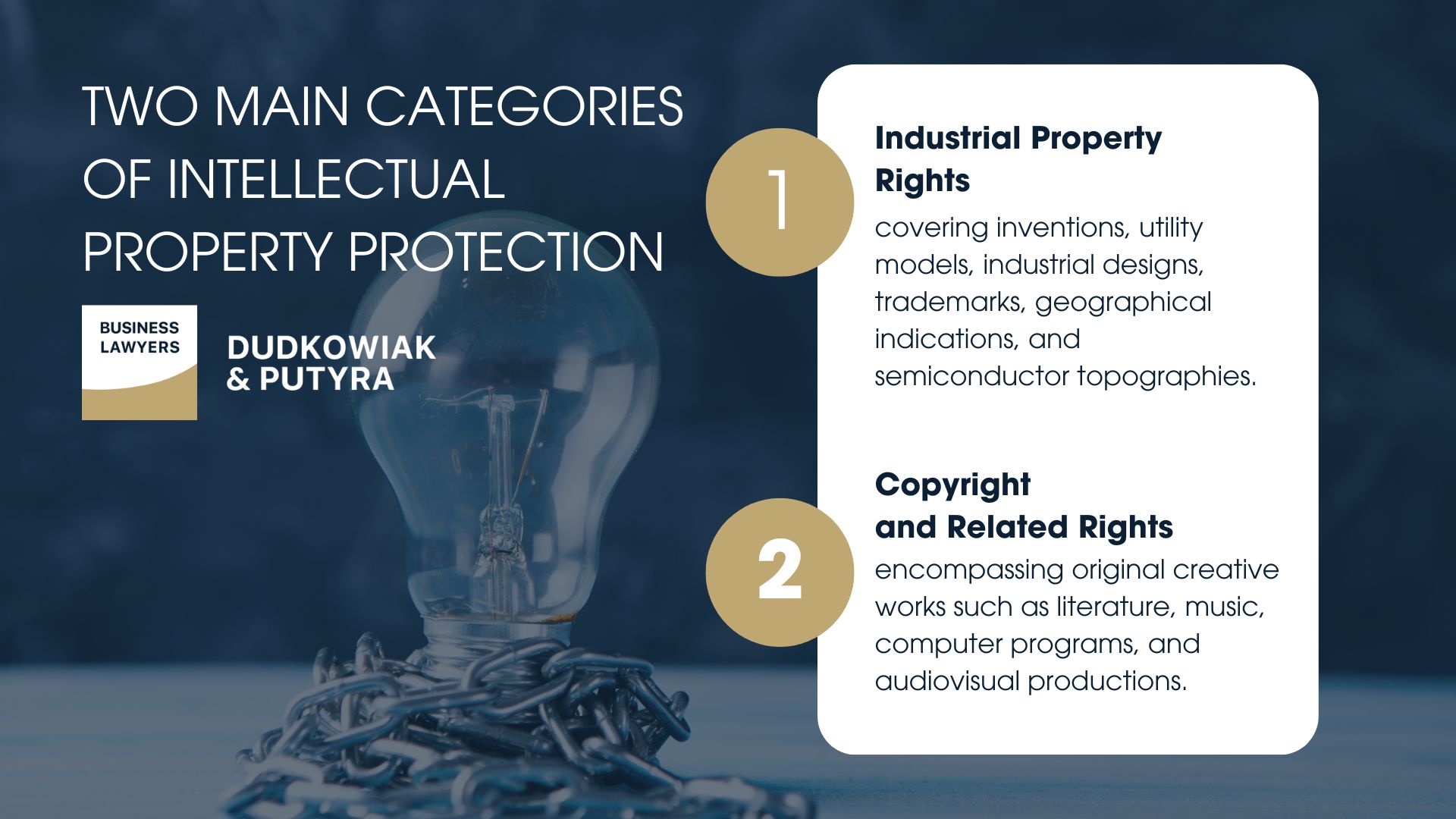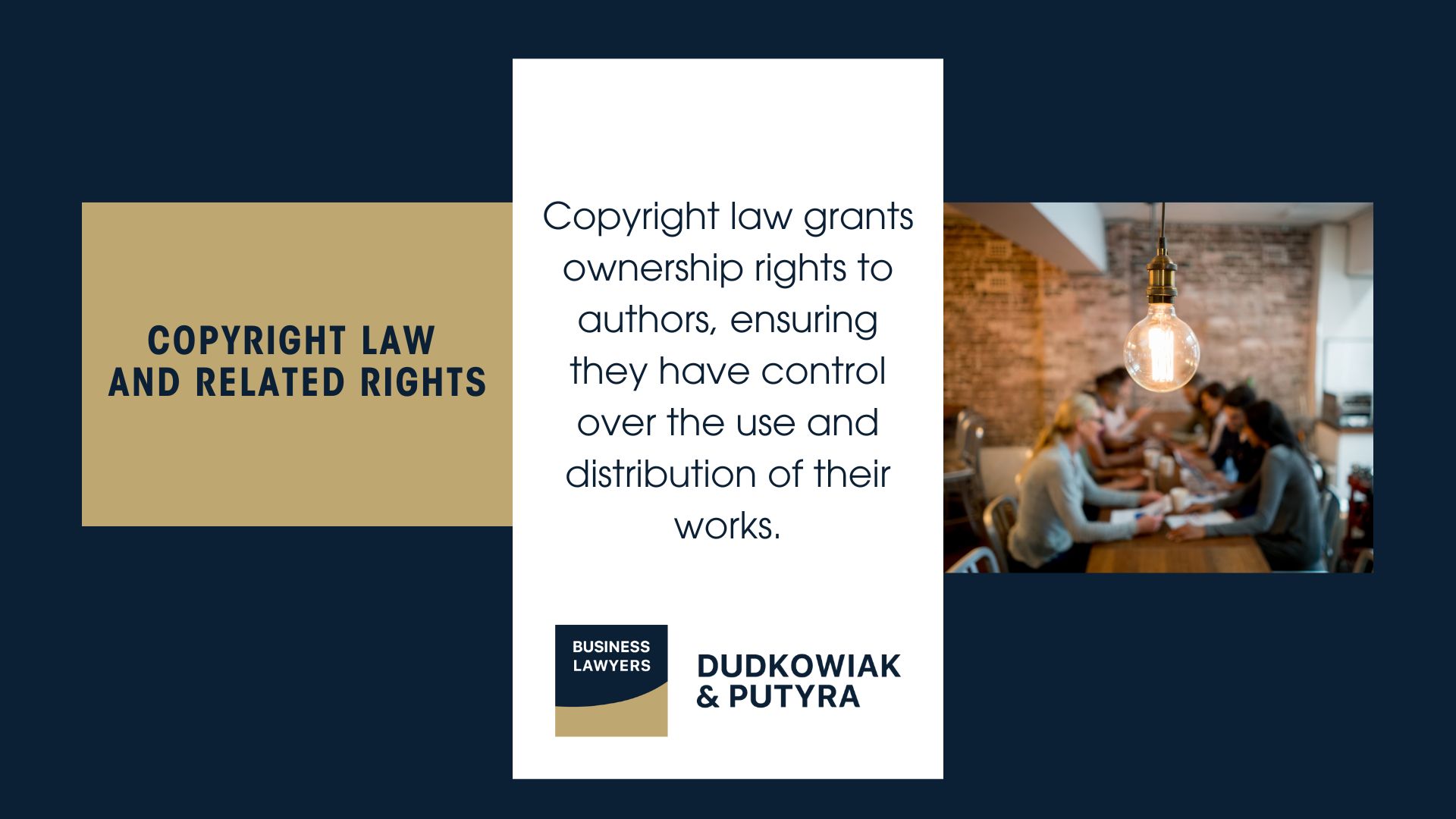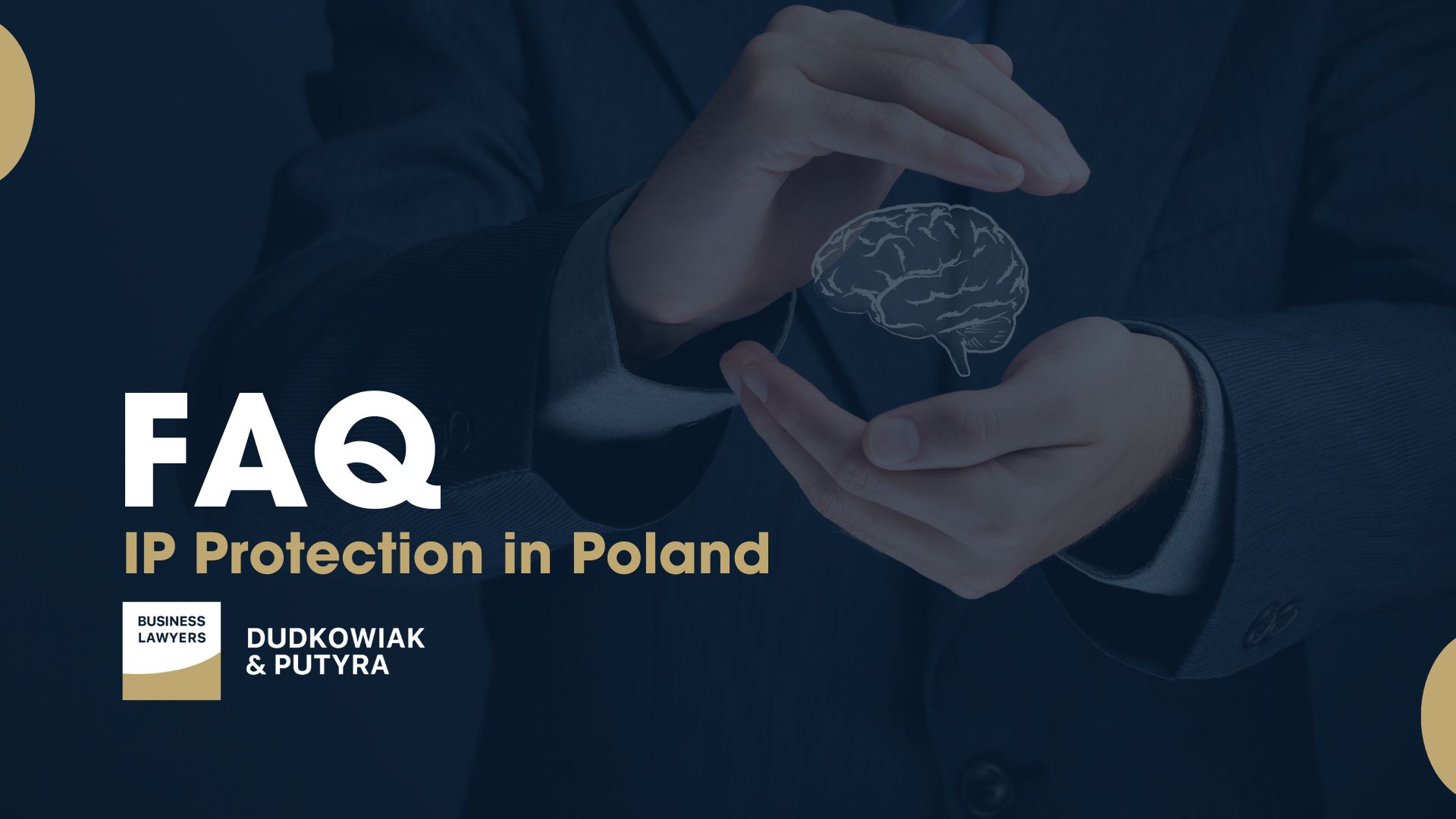Last updated: 25.06.2025
Intellectual property law in Poland
In today’s competitive business landscape, intellectual property (IP) protection plays a crucial role in ensuring the success and longevity of enterprises.
Polish businesses, regardless of their size or industry, can significantly benefit from securing their innovations, trademarks, and creative works through a well-structured IP strategy.
In this article, we explore the different types of intellectual property rights in Poland and how they are protected under both national legislation and international agreements.
What is Intellectual Property (IP)?
Generally speaking, Intellectual property refers to creations of the human intellect that possess an intangible nature but are embodied in tangible forms. This includes in particular inventions:
- designs,
- artistic works,
- computer programs,
- service marks,
- and trade secrets.
While intellectual property is different from physical property, it is no less valuable in terms of economic rights and financial benefits. Intellectual property rights also contribute directly to a company’s economic value by enabling monetization of innovations.
The legal framework governing IP rights in Poland provides mechanisms to safeguard these tangible assets, allowing businesses to protect their investments, maintain a competitive edge, and enhance their brand value.
The primary legal acts regulating intellectual property in Poland include the Industrial Property Law Act of 2000, the Act on Copyright and Related Rights of 1994, and international treaties such as the Paris Convention and TRIPS Agreement.
Moreover, Poland as a member of EU is bound by community legislation including among others Regulations 2017/1001 on the European Union trade mark and Regulations 6/2002 on the community design.
Polish IP laws distinguish between two primary categories:
- Industrial Property Rights – covering inventions, utility models, industrial designs, trademarks, geographical indications, and semiconductor topographies.
- Copyright and Related Rights – encompassing original creative works such as literature, music, computer programs, and audiovisual productions.

What Types of IP Are Protected in Poland?
Trademark
Trademarks are one of the most common forms of IP protection, allowing businesses to differentiate their products and services from competitors.
A trademark can be a word, phrase, symbol, design, or a combination of these elements that identifies a particular business. There are also unconventional trademarks such as 3D or moving signs as well as unseen sings such as sounds or smells.
Trademark infringement arises when a third party uses a sign similar or identical to a registered trademark in a way that confuses consumers. Trademark infringement occurs both at the national and EU level and must be addressed to preserve brand identity.
Protection and Registration
- In Poland, trademarks are registered with the Patent Office of the Republic of Poland (UPRP).
- A trademark is valid for 10 years from the date of application and can be renewed indefinitely upon payment of renewal fees.
- Businesses can also seek protection at the EU level through EUIPO (European Union Intellectual Property Office) or internationally via WIPO (World Intellectual Property Organization).
- Trademark protection is governed by the Industrial Property Law Act, ensuring exclusivity and legal recourse against infringement.
Industrial Designs
Industrial designs protect the aesthetic appearance of a product, covering elements such as shapes, patterns, and colors that define the visual appeal of an item.

Protection and Registration
- The maximum protection period for an industrial design in Poland is 25 years, subject to renewal every 5 years.
- Registration can be done at UPRP for national protection, EUIPO for EU-wide coverage, or via WIPO’s Hague System for broader international protection.
- The design must be novel and possess an individual character, meaning it should not be identical or too similar to existing designs.
- The Industrial Property Law Act provides legal standards for industrial design protection, ensuring compliance with EU directives.
Patent Protection and Utility Models in Poland
Patents protect inventions that offer technical solutions to problems, while utility models (sometimes called “small patents”) cover simpler technical innovations.

Protection and Registration
- Patents are granted for 20 years, provided that annual maintenance fees are paid.
- Utility models offer a shorter protection period of 10 years.
- Patent applications must be filed with UPRP, or businesses can seek international protection via the European Patent Office (EPO) or WIPO’s PCT (Patent Cooperation Treaty) system.
- Patent rights are territorial, meaning protection must be sought separately in different jurisdictions.
- Some categories, such as business methods, mathematical algorithms, and natural discoveries, are not patentable under Polish law.
- Patents are regulated by the Industrial Property Law Act, ensuring innovation-driven enterprises benefit from legal protection.
- The Polish patent system provides a structured legal framework that supports inventors in obtaining, maintaining, and enforcing their exclusive rights both nationally and internationally.
Geographical Indications
Geographical indications (GIs) identify a product as originating from a specific location where quality, reputation, or other characteristics are inherently linked to its geographic origin.
Protection and Registration
- GIs for industrial products are registered with UPRP.
- Agricultural and food products must be registered with the European Commission via Poland’s Ministry of Agriculture.
- Protection is granted indefinitely as long as the criteria for the geographical indication are met.
- Only collectives (e.g., producer groups or local authorities) can apply for GI protection, not individual businesses.
- The Geographical Indications Protection Act aligns Polish regulations with EU law.
Copyright Law and Related Rights
Copyright protects original works of authorship, including:
- literary works,
- software,
- music,
- films,
- and artistic creations.
Copyright law grants ownership rights to authors, ensuring they have control over the use and distribution of their works.

Protection and Enforcement
- In Poland, copyright protection arises automatically upon the creation of a work, without the need for registration.
- Copyright protection in principle lasts for 70 years after the death of the author.
- Related rights include protection for performers, producers, and broadcasters of original works.
- The scope of protection covers unauthorized use, reproduction, distribution, and adaptation.
- Copyrighted works may be licensed or assigned to third parties under contractual agreements.
- The Act on Copyright and Related Rights of 1994 governs copyright enforcement in Poland.
Semiconductor Topographies
This rare category of IP protection covers the three-dimensional layout of electronic circuits in semiconductor chips.
Protection and Registration
- The protection period lasts 10 years from the date of first commercial use or application for registration.
- Applications must be filed with UPRP.
- The layout must be original and not previously commercially exploited.
- Semiconductor topographies are regulated under the Industrial Property Law Act.
How to enforce Intellectual Property Rights in Poland?
Protecting intellectual property is only effective if businesses actively enforce their rights against infringement.
In Poland, IP rights enforcement can be pursued through:
- Administrative Proceedings:
The Patent Office handles oppositions to the registration of a trademark (e.g., when it infringes on prior rights), as well as applications to invalidate or extinguish a patent, design or trademark.
- Civil Litigation:
IP owners can file lawsuits for damages, injunctions, and seizure of counterfeit goods.
- Customs Enforcement:
Owners of trademarks can effectively help protect trademarks by seizing goods that infringe intellectual property rights. In Poland, this is handled by the National Tax Administration (KAS), which operates under national and EU customs regulations. It is possible to submit a trademark to the AFA (Application for Action) system, which enables more effective action at EU borders.
- Criminal Sanctions:
In cases of serious infringement, criminal charges may apply, leading to fines or imprisonment.
- Alternative Dispute Resolution:
Mediation and arbitration offer a cost-effective and faster alternative to court proceedings.
- Enforcement mechanisms are outlined in the Industrial Property Law Act and the Act on Copyright and Related Rights as well as from EU and Polish customs laws.
Effective enforcement and licensing frameworks also facilitate technology transfer, enabling the lawful sharing and commercialization of protected innovations between enterprises and research institutions in compliance with Polish and EU law.
Why Strong IP Strategy is so important?
A well-developed IP strategy is crucial for businesses to:
- Maximize competitive advantage by protecting key innovations and branding elements.
- Optimize financial resources by ensuring cost-effective IP protection.
- Reduce risk exposure related to legal disputes and potential IP theft.
- Enhance market value by increasing the company’s intangible asset portfolio.
- A strategic IP approach also contributes to long-term economic growth by encouraging innovation and investment in knowledge-based assets.
Protecting IP in Poland: Key Takeaways
Understanding and utilizing IP laws in Poland is essential for businesses looking to safeguard their innovations, maintain a competitive advantage, and maximize the value of their assets.
Whether protecting trademarks, patents, industrial designs, or copyrights, companies should proactively manage their IP portfolio and seek legal expertise to ensure full compliance with the Polish Industrial Property Law Act and other relevant legislation.
FAQ – IP Protection in Poland
How does IP law in Poland support businesses in protecting innovation?
Polish IP law provides a structured legal framework that enables businesses to safeguard innovations, maintain competitive advantage, and monetize intellectual assets. Through mechanisms such as patent protection, trademark registration, and copyright enforcement, the law ensures that enterprises can protect both the functional and creative aspects of their work.
Additionally, Poland’s alignment with EU regulations and international treaties strengthens cross-border IP protection and legal certainty for companies operating globally.
How long does patent protection last in Poland?
Under Polish patent law, patent grants are issued for a limited period of 20 years from the filing date, provided annual fees are paid. This duration aims to stimulate innovation and ensure that inventors benefit from legal exclusivity while contributing to technological progress.
Where can I register a trademark in Poland?
Trademarks are registered with the national trademark office, officially known as the Patent Office of the Republic of Poland.
Trademark owners benefit from legal protection, which helps protect IP and prevent misuse. Poland also participates in international systems via EUIPO and WIPO.
Is Polish IP law aligned with international standards?
Yes. Poland is a member of the World Trade Organization and the United Nations, and its IP regulations reflect obligations under international treaties.
These frameworks serve the public interest, particularly in developing countries, where countries recognize the need for access to innovation while safeguarding IP.
What happens when patent infringement occurs in Poland?
Patent infringement occurs when a third party uses, manufactures, or sells a patented invention without the consent of the patent owner.
The patent owner may seek civil remedies such as damages or injunctive relief. In serious cases, infringement may also lead to criminal liability under Polish patent law.
What makes trade secrets different from patents?
Unlike patents, trade secrets are not registered and can be protected indefinitely, provided that proper safeguards – such as confidentiality agreements – are in place. This form of protection allows businesses to retain control over sensitive information with potential commercial value.
Who can help enforce intellectual property rights in Poland?
Intellectual property lawyers support clients in protecting their IP assets and asserting exclusive rights.
Their expertise is essential in handling disputes related to patent infringement, copyright infringement, or intellectual property theft, particularly in litigation involving other parties.
How does Polish IP law protect geographical indications?
Geographical indications are protected under both national and international regulations in Poland.
This form of intellectual property protection ensures that products associated with a specific geographical origin – such as regional foods or crafts – are recognized for their unique qualities and reputation, helping to preserve local heritage and promote economic value.


